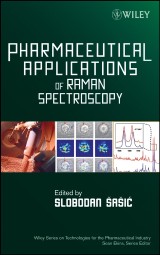Details

Pharmaceutical Applications of Raman Spectroscopy
1. Aufl.
|
117,99 € |
|
| Verlag: | Wiley |
| Format: | |
| Veröffentl.: | 23.10.2007 |
| ISBN/EAN: | 9780470225875 |
| Sprache: | englisch |
| Anzahl Seiten: | 280 |
DRM-geschütztes eBook, Sie benötigen z.B. Adobe Digital Editions und eine Adobe ID zum Lesen.
Beschreibungen
Raman spectroscopy has advanced in recent years with increasing use both in industry and academia. This is due largely to steady improvements in instrumentation, decreasing cost, and the availability of chemometrics to assist in the analysis of data. <br /> <p><br /> </p> <p>Pharmaceutical applications of Raman spectroscopy have developed similarly and this book will focus on those applications. Carefully organized with an emphasis on industry issues, Pharmaceutical Applications of Raman Spectroscopy, provides the basic theory of Raman effect and instrumentation, and then addresses a wide range of pharmaceutical applications. Current applications that are routinely used as well as those with promising potential are covered. Applications cover a broad range from discovery to manufacturing in the pharmaceutical industry and include identifying polymorphs, monitoring real-time processes, imaging solid dosage formulations, imaging active pharmaceutical ingredients in cells, and diagnostics.</p>
Preface. <p>Contributors.</p> <p><b>1. Introduction to Raman Spectroscopy</b> (<i>Yukihiro Ozaki and Slobodan Sasic</i>).</p> <p>1.1 Histor of Raman Spectrodcopy.</p> <p>1.2. The Principle of Raman Spectroscopy.</p> <p>1.3 An Example of Simpel Raman Spectrum: Raman Spectrum of Water.</p> <p>1.4 Characteristics of Raman Spectroscopy.</p> <p>1.5 The Classic Theory fo Raman Effect.</p> <p>1.6 The Quantum Theory of Raman Scattering.</p> <p>1.7 Ctross Section.</p> <p>1.8 Relevance to Pharmaceuticals.</p> <p>1.9 Resonance Raman Effect.</p> <p>1.10 Instrumentation for Raman Spectroscopy.</p> <p><b>2. Quantitative Analysis of Solid Dosage Formulations by Raman Spectroscopy</b> (<i>Steven E.J.Bell</i>).</p> <p>2.1 Introduction.</p> <p>2.2 Quantitative Analysis.</p> <p>2.3 Instrumental Parameters.</p> <p>2.4 Experimental Considerations.</p> <p>2.5 Nonstandard Samples.</p> <p>2.6 Conclusions.</p> <p><b>3. Surface Enhanced Resonance Raman Scatttering</b> (<i>W. Ewen Smith</i>).</p> <p>3.1 Theory.</p> <p>3.2 The Exper4imental Setup.</p> <p>3.3 Examples of SERS/SERRS Assays.</p> <p><b>4. Raman Spectroscopy for Identifying Polymorphs</b> (<i>Fred Laplant and Anne De Paepe</i>).</p> <p>4.1 Introduction of Polymorphism.</p> <p>4.2 Instrumental Methods of Polymorph Characterization.</p> <p>4.3 Polymorph Screening.</p> <p>4.4 Process Control.</p> <p>4.5 Polymorph Quantitation.</p> <p>4.6 Calibration Set and Sample Preparation.</p> <p>4.7 Quantitation.</p> <p>4.8 Intellectual Property.</p> <p><b>5. Raman Spectroscopy for Monitoring Real-time Processes in the Pharmaceutical Industry</b> (<i>Kevin L. Davis, Mark S. Kemper and Ian R. Lewis</i>).</p> <p>5.1 Introduction.</p> <p>5.2 A Brief History of Raman Spectroscopy.</p> <p>5.3 Basic Theory of Raman Spectroscopy.</p> <p>5.4 General Instrumentation for Raman Spectroscopy.</p> <p>5.5 The Choice-Dispersive or FT?.</p> <p>5.6 Process Analysis and PAT.</p> <p>5.7 Why Choose Raman as a PAT Tool? The Need for Raman.</p> <p>5.8 Data Analysis.</p> <p>5.9 Applications.</p> <p>5.10 Conclusions.</p> <p><b>6. Raman Chemical Imaging of Solid Dosage Formulations</b> (<i>Slobodan Sasic</i>).</p> <p>6.1 Methods for Chemcial Imaging.</p> <p>6.2 Data Analysis.</p> <p>6.3 Experimental.</p> <p>6.4 Applications.</p> <p><b>7. In vivo Raman Confocal Microspectroscopy of Skin</b> (<i>Andre van der Pol, William M. Riggs and Peter J. Caspers</i>).</p> <p>7.1 Introduction.</p> <p>7.2 Applications.</p> <p>7.3 Summary and Discussion.</p> <p><b>8. Raman Microspectrscopy and Imgaging of Active Pharmaceutical Ingredients in Cells</b> (<i>Jian Ling</i>).</p> <p>8.1 Introduction.</p> <p>8.2 Current Appraoches to Drug Imaging.</p> <p>8.3 Raman Spectroscopy and Raman Imaging.</p> <p>8.4 Raman Microspectroscopy and Imaging for Drug Research.</p> <p>8.5 Raman Intensity, Fluorescence Background, and SNR.</p> <p>8.6 Techniques to Improve SNR in Raman Imaging.</p> <p>8.7 Enhanced Raman Images with Postprocessing.</p> <p>8.8 Raman Imaging of Intracellular Distribution of Paclitaxel in Living Cells.</p> <p>8.9 Raman Imaging of Intracellular Distribution of Sulindac Sulfide in Fixed Cells.</p> <p>8.10 Conclusions and Future Outlook.</p> <p><b>Index.</b></p>
Principal Scientist, Analytical Research & Development, Pfizer, Inc., Sandwich, UK
Raman spectroscopy has advanced in recent years with increasing use both in industry and academia. This is due largely to steady improvements in instrumentation, decreasing cost, and the availability of chemometrics to assist in the analysis of data. <br /> <p><br /> </p> <p>Pharmaceutical applications of Raman spectroscopy have developed similarly and this book will focus on those applications. Carefully organized with an emphasis on industry issues, Pharmaceutical Applications of Raman Spectroscopy, provides the basic theory of Raman effect and instrumentation, and then addresses a wide range of pharmaceutical applications. Current applications that are routinely used as well as those with promising potential are covered. Applications cover a broad range from discovery to manufacturing in the pharmaceutical industry and include identifying polymorphs, monitoring real-time processes, imaging solid dosage formulations, imaging active pharmaceutical ingredients in cells, and diagnostics.</p>

















